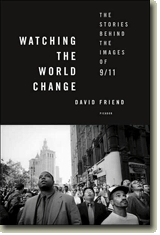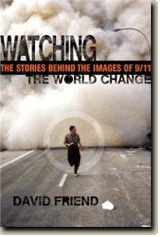Reviews & Reactions
GARRISON KEILLOR, THE NEW YORK TIMES BOOK REVIEW:
A brief review can't do justice to Watching the World Change, a lucid, thoughtful and wide-ranging book. In truth, Friend's excellent writing conveys more of the truth of the day than photographs can.
LUC SANTE:
It is gripping, profound, far-reaching -- in fact, an entirely new way of writing about history, a stunning achievement.
FRANK RICH, THE NEW YORK TIMES:
"Compelling...surely the most original treatment so far of the cultural impact of the day."
SAN FRANCISCO CHRONICLE:
“[A] powerful, riveting, often emotional, [a] tour d’horizon… Its author never los[es] sight of the human lives lost. It is a tribute to Friend’s sense of proportion – and to his essential humanity.”
CHICAGO TRIBUNE:
“Riveting…wide-ranging and stimulating [by] a skilled and lively writer.”
HARTFORD COURANT:
“[Friend] covers the visual record of post 9/11 America with the same attention to detail and hard analysis that David Halberstam devotes to political events.”
CHRISTIAN SCIENCE MONITOR:
“A fascinating day by day account…with perceptive commentary.”
ATLANTA LIFE:
“At times, his eloquent prose reads like poetry that begs to be reread….Friend’s book forces us to remember what we want to forget.”
ENTERTAINMENT WEEKLY:
An impressively sweeping analysis. When it comes to 9/11, no, we haven't see everything [yet]. A-.
MARIANNE FULTON:
Friend's book is riveting. He takes us back through that horrible day, step by step. Thne he lays out all the implications (and I do mean "all") of imagery intersecting reality, memory and understanding. Friend's writing is sharp, incisive, and also quite visual.
PEOPLE MAGAZINE:
"A fresh look [at 9/11]"
THE ATLANTIC MONTHLY:
"Writing with the distance offered by the lens, Friend creates a cool, critical space for the consideration of tragedy."
ANDERSON COOPER:
“As I read Watching The World Change, my pulse began to quicken. This is an intricately woven tale of that terrible day, and terrible week, that is both gripping and thought-provoking. The images, of course, are seared in our consciousness, but after reading this book you will look at them in a whole new way. Much has been written about 9/11, but David Friend shows it to us as no one has before.”
DAN RATHER:
“The story of 9/11 and its aftermath was one told largely through images; now David Friend gives us the story behind the images themselves, in harrowing, thoughtful, and often moving detail.”
ROBERT STONE:
"To read Watching the World Change is an overwhelming experience. Beautifully written and observed, as a tribute to the dead, it embodies the Buddhist wisdom about change, life, and the world more than anything written after the events of that day.
“A reader can only bear witness to the tenderness and wisdom at the core of this book, which distinguish it throughout. David Friend's passionate sympathy engages the reader without relenting. Just about all the observations that might be sought from the events of that day are here: victims, survivors in every sense, responders. Loss, pride, a helix of sorrow and shame along the meridians of the world. Along with its records of grief, Watching the World Change celebrates the courage to go on, which may be the most admirable and irreplaceable of human virtues."
CHRISTOPHER HITCHENS:
"The crystalline images of September 11 soon became blurred, either by hysteria or exploitation or by a certain reticence that mutated into near-denial. At last we have a book that looks steadily through the lens and does not flinch, but which cancels voyeurism by its care and measure and by the multiplicity of its perspectives."
PUBLISHERS WEEKLY:
[Starred Review]
Friend, a former director of photography at Life and currently editor of creative development at Vanity Fair, writes: "For many of us, photos are the glue we use to hold in place the disjointed bits of fiction and fact that make up the stories of our lives." In this important analysis of how images of 9/11 and the "war on terror" have altered our understanding of power, world politics, religion and identity, he successfully merges reportage and analysis as he interprets the images of falling towers, panic in Manhattan streets and prisoners at Abu Ghraib that have been burned into our brains. But Friend elevates the book to a higher level with his iridescent commentary on the broad political and philosophical implications of 9/11 photography. For example, he recognizes the need to identify victims of a disaster as well as the Orwellian impulses in potential federal programs to create national photo ID cards. And he takes on such complicated issues as self-censorship in the media and how the Bush administration quickly learned how to use images to kick-start and maintain the war on terror. Lucidly written and urgently argued, this essential book is a valuable addition to literature on contemporary media and current politics.
KIRKUS REVIEWS:
A star is assigned to books of unusual merit, determined by the editors of Kirkus Reviews.
A photojournalist (formerly of Life, now Vanity Fair) examines the images of 9/11—from the iconic to the lesser-known—and discusses photography's pervasive presence in that disaster and in contemporary culture.
Friend first tells the stories of those photographers, amateur and professional, who had cameras pointed at the World Trade Center on that crisp fall morning, then moves into a fascinating description of the use of photography in the aftermath. He talks about photos taken from an NYPD helicopter; the video of George W. Bush in that Florida classroom, as an aide whispered to him the news; the photos and X-rays used to identify victims' remains; the proliferation of posters featuring the images of missing loved ones; efforts by galleries and museums to display artifacts and photos; the anger many felt when images of the catastrophe (and of Ground Zero) were sold for profit. He explores the efforts of the electronic media to cover the crisis. He discusses the possibility that a video of Osama bin Laden released just before the 2004 election helped Bush defeat John Kerry. He tells of people who claimed to see images of angels and devils in the clouds of smoke billowing from the buildings. Friend introduces a fireman's widow who ate her meals looking at a large photograph of her husband positioned in a chair across the table. He examines the role of photography in the lead-up to and execution of the military actions in Afghanistan and Iraq, including Colin Powell's presentation at the U.N., the "imbedded" photojournalists, the president's "Top Gun moment" on the carrier Abraham Lincoln, Abu Ghraib and more. Friend ends with the complex story of what became a symbol of Ground Zero: the celebrated image of three firemen raising the American flag—à la Iwo Jima—in the rubble.
An informed and intimate account—accompanied by some disturbing photos—of one of the worst days in American history.
RICHMOND (VA.) TIMES DISPATCH:
Impressively articulate insight...meticulously written, carefully considered.
RALEIGH (N.C.) NEWS & OBSERVER:
Fascinating...If this book is any judge, this brave new world could alter the nature of human empathy, tilting it more to the power of the image.
NEW ORLEANS TIMES PICAYUNE:
Elegant and moving...beautifully written.
THE COMMON REVIEW (GREAT BOOKS FOUNDATION):
Invaluable...vivid and thoughtful. He has begun the valuable process of explaining how the visual record will play out in history, and how those images require language, require story, in order to make sense at all. Finally, Friend is also quite perceptive about the political consequences, and the political manipulation of photographs for the sake of policy.
THE WALL STREET JOURNAL:
"Turns a familiar story around and helps us understand why we saw event as we did."
O, THE OPRAH MAGAZINE:
“In painstaking – one could say, loving – detail, Friend recounts the individual histories.”
THE OREGONIAN:
“[A] tour de force.”
BOOKPAGE:
"Captivating...gripping...Friend makes a strong argument that the images tell the real story."
THE ATLANTA JOURNAL-CONSTITUTION:
“Friend has done a massive amount of gumshoe work in tracking down the stories behind the images themselves.”
THE BRITISH JOURNALISM REVIEW:
“Impressively-researched. . . revealing. . . Friend communicates a profound knowledge and love of photography.”


